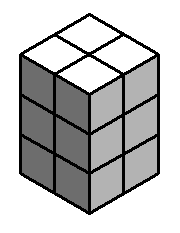Teaching Surface Area
Thursday, 25 November 2010 | 1 Comment
I like teaching surface area, I think it’s an interesting topic. Yet, I find kids struggle with the concept. Not understanding the basics of area and then getting over the prior knowledge of solids meaning volume are two aspects that cause some difficulty.
This is how I break down surface area for my low ability Year 8 class.

Lesson 1 – Introducing Surface Area
- Investigate Surface Area using Centicubes (comparing with Volume).
- From a net, make a solid and find the surface area.
- Find the surface area by drawing a net and counting squares.
- Find the surface area from nets where the area of each face is shown.
Lesson 2 – Rectangular Prisms
- Find the surface area of solids where the area of some faces shown (e.g. show the front, top and side of a rectangular prism).
- Find the surface area of a cube given the length of a single edge.
Concepts: understand that the faces of a rectangular prism come in pairs.
- Find the surface area of a rectangular prism given the length of 3 edges.
Concepts: determine which lengths are used for each face and that faces have a matching face so the area of a face can be doubled.
Lesson 3 – Triangular Prisms
- Review area.
- Students draw a 3cm square and find it’s area. Then, draw a diagonal and find the area of the resulting triangle(s).
- Students draw a 4 by 5cm rectangle and find it’s area. Then, draw a diagonal and find the area of the resulting triangle(s).
- Determine a means for finding the area of a triangle.
- Make two triangular prisms.
- Show my triangular prism t-shirt box for which I’ve made peel off sides, peel off each side and form the net.
- Complete some exercises given diagrams of triangular prisms with side lengths.
Lesson 4 – Smarties
- Determine the surface area of a Smarties box
- Design a Toblerone box
Posted in • Lesson Idea • Surface Area • Printable • Worksheet | Short URL: http://mths.co/2047
Post a comment
Commenting is not available in this channel entry.New Subscribe to the …
MathsLinksemail newsletter
Get updates…
About
Simon Job — eleventh year of teaching maths in a public high school in Western Sydney, Australia.
MathsClass is about teaching and learning in a maths classroom. more→
Archive
Elsewhere
 @simonjob
@simonjob
updates via  @mathslinks
@mathslinks
Recently read/found.
Being a Vector is not Mutually Exclusive – Ringo Mok
maths vectorsInstagram
Gcf howie_hua maths
Comments